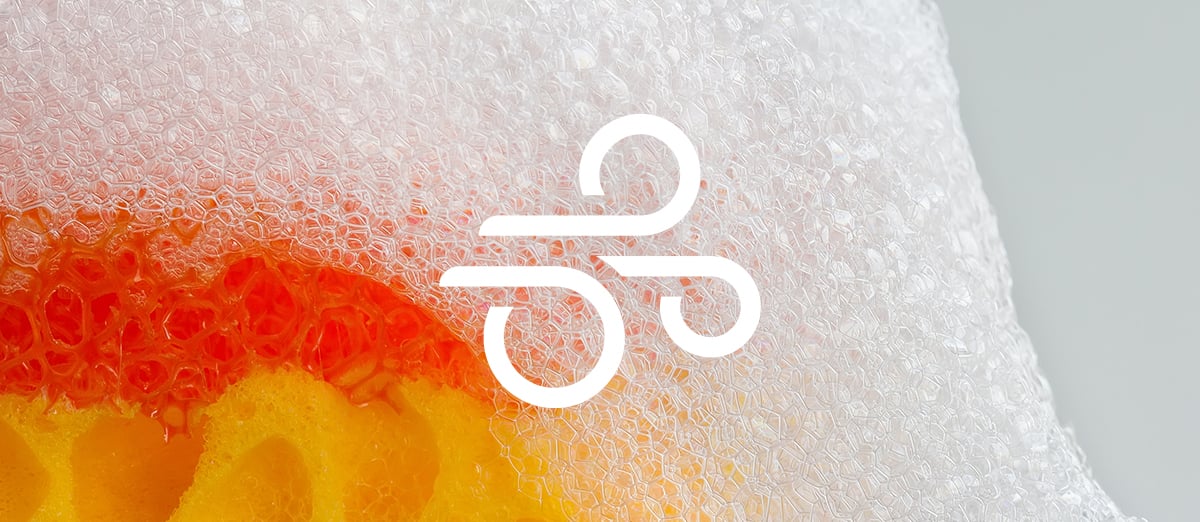A healthy and happy home always includes good indoor air quality. In this article we've explained what airborne chemicals (VOCs) are, their health impact, and, most importantly, our top tips to reducing them.
Contents
- What are airborne chemicals (VOCs)?
- Why should I care about airborne chemicals?
- Top tips to reduce airborne chemical (VOCs) indoors
What are airborne chemicals (VOCs) and where do they come from ?
VOCs stands for Volatile Organic Compounds, which are a combination of odors and aromas emitted from chemicals. Many can be found in everyday products.
Listen to your nose: when something smells, it is more than likely emitting airborne chemicals. Even things that smell nice like perfume or air fresheners can have negative effects. To learn more about them, check out our in-depth VOC page here→
Why should I care about airborne chemicals (VOCs)?
Studies have found that levels of several airborne chemicals average 2 to 5 times higher indoors than outdoors. These high levels can cause eye, nose and throat irritation, headaches, as well as more serious health impacts such as impacts on the liver1. 
Top tips to reduce airborne chemical (VOCs) indoors
Monitoring airborne chemicals means that you can rest easily, you will be notified when levels rise, and take these easy steps to reduce your levels. Moreover, listen to your nose: when something smells, it is more than likely emitting VOCs. Even good smelling things like perfume or air fresheners have negative effects.
1. Choose your paint wisely
 High levels of VOC solvents in paint contribute to pollution and reduce the overall indoor air quality. More and more governing bodies are taking initiative to create certification programs that explain to consumers which paints contain low VOCs, and therefore are low risk. When redecorating, consider choosing paints with low VOCs as shown through labels that are designated ‘low VOC’, ‘No VOC’, ‘Zero VOC’ etc.
High levels of VOC solvents in paint contribute to pollution and reduce the overall indoor air quality. More and more governing bodies are taking initiative to create certification programs that explain to consumers which paints contain low VOCs, and therefore are low risk. When redecorating, consider choosing paints with low VOCs as shown through labels that are designated ‘low VOC’, ‘No VOC’, ‘Zero VOC’ etc.
2. The unseen benefits of used furniture
 With the surge of interest into up-cycling, repurposing furniture and flea market finds, you will be happy to know there is also an excellent health benefit that comes along with used furniture! Off-gassing from new furniture is often most prominent in the first few life years of the product, so second-hand furniture will reduce this risk. It is good for the environment, more cost-efficient and provides peace of mind. What's not to love?
With the surge of interest into up-cycling, repurposing furniture and flea market finds, you will be happy to know there is also an excellent health benefit that comes along with used furniture! Off-gassing from new furniture is often most prominent in the first few life years of the product, so second-hand furniture will reduce this risk. It is good for the environment, more cost-efficient and provides peace of mind. What's not to love?
3. Cleaning products
 It is no secret that cleaning the house lifts your spirits. This feeling of satisfaction can be doubled by choosing cleaning products marked 'low' or 'no VOCs'. This is because they are more environmentally friendly, as it has been found that VOCs in cleaning products decrease the indoor air quality and contribute to smog formation in outdoor air2.
It is no secret that cleaning the house lifts your spirits. This feeling of satisfaction can be doubled by choosing cleaning products marked 'low' or 'no VOCs'. This is because they are more environmentally friendly, as it has been found that VOCs in cleaning products decrease the indoor air quality and contribute to smog formation in outdoor air2.
The cleaning products which you should watch out for most include detergents, air fresheners, furniture polish, oven cleaner, carpet cleaner and other varnishes. If in doubt, the U.S. General Services Administration GSA Environmental products and services guides offer detail product information to help make more environmentally friendly purchases3.
3. Store your chemicals safely away
 Following the theme of tidying, keeping chemicals, cleaning products and paints in an unattached garage or shed is recommended.
Following the theme of tidying, keeping chemicals, cleaning products and paints in an unattached garage or shed is recommended.
It is not simply the consumption of such products like paint, varnishes, heavy cleaning supplies etc. that are hazardous. They actually omit gasses in a process called 'off-gassing' which can infiltrate a room and reduce indoor air quality.
4. Ventilate, ventilate, ventilate!

Increasing ventilation through opening windows, clearing air vents, installing under door vents, are each small changes that can help combat high levels.
A great way to optimize indoor ventilation is to monitor indoor air quality and adjust ventilation based on the results. You can breathe easy knowing that you'll be notified when levels are on the rise, and can adjust accordingly.










.webp)